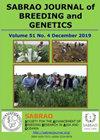利用7s蛋白对采后鲜食葡萄抗灰霉病的绿色生化保护
IF 1.7
Q3 PLANT SCIENCES
引用次数: 0
摘要
从大豆和鹰嘴豆种子中分离得到的7S球蛋白(种子贮藏糖蛋白)对葡萄灰霉病病原菌(葡萄灰霉病菌)有较强的抗真菌活性,并与合成杀菌剂Switch 62.5 WG进行了比较。传统的微生物学方法估计了7S球蛋白的体外抗真菌潜力,如线性生长曲线和扫描电子显微镜(SEM)。在50、100和200 μg/mL浓度下,大豆-7S对灰葡萄孢的体外生长抑制作用分别为64.44%、66.64%和76.67%;鹰嘴豆-7S对灰葡萄孢的体外生长抑制作用分别为52.22%、54.44%和66.67%。合成杀菌剂(Switch 62.5 WG)在50 μg/mL和200 μg/mL浓度下,对真菌的生长抑制率分别为83.33%和86.66%。在扫描电镜下,7s暴露的葡萄球菌菌丝较对照肿胀。从大豆和鹰嘴豆中提取的7S分别在200和400 μg/mL浓度下对鲜食葡萄灰霉病的生长有抑制作用。维持的疾病严重程度也很低(大豆- 7s和鹰嘴豆- 7s分别为40%和25%)。增加处理水平(400 μg/mL),在低温条件下储存30天后,两种蛋白质的疾病严重程度大大降低,仅为7.5%。从豆科植物种子中提取的7S球蛋白可作为人工杀菌剂的替代品,在采后处理中防治灰霉病。开发这些豆科蛋白质作为天然杀菌剂也可以在安全控制各种植物病原体方面取得进展,这些病原体造成了巨大的作物损失。本文章由计算机程序翻译,如有差异,请以英文原文为准。
GREEN BIOCHEMICAL PROTECTION OF POSTHARVEST TABLE GRAPES AGAINST GRAY MOLD (BOTRYTIS CINEREA) USING 7S PROTEINS
The 7S globulins (seed storage glycoprotein) isolated from soybean and chickpea seeds have the antifungal potential against the pathogenic fungus (Botrytis cinerea) causing gray mold in grapes assessing table grapes in vitro or postharvest by comparing with synthetic fungicide, Switch 62.5 WG. Conventional microbiological procedures estimated the in-vitro antifungal potential of the 7S globulins, such as linear growth curves and scanning electron microscopy (SEM). Soybean-7S significantly inhibited the in-vitro growth of Botrytis cinerea by about 64.44%, 66.64%, and 76.67% when applied at 50, 100, and 200 μg/mL, respectively, followed by chickpea 7S with growth reduction of 52.22%, 54.44%, and 66.67%, respectively. The synthetic fungicide (Switch 62.5 WG) induced higher growth inhibition extents (83.33% and 86.66%) when applied at 50 and 200 μg/mL, respectively. The 7S-exposed B. cinerea displayed swollen hyphae compared with the control under scanning electron microscope examination. The 7S derived from soybean and chickpea inhibited gray mold development in table grapes when applied at 200 and 400 μg/mL for 30 days after infection with B. cinerea. The maintained disease severity was also minimal (40% and 25% for soybean-7S and chickpea-7S, respectively). An increased level of treatment (400 μg/mL) highly reduced the disease severity to only 7.5% after 30 days of storage at cold conditions for both proteins. The 7S globulin from legume seeds can be an alternative to synthetic fungicides for controlling B. cinerea as a postharvest treatment. Developing these legume proteins as natural fungicides could also progress for the safe control of various plant pathogens, causing drastic crop losses.
求助全文
通过发布文献求助,成功后即可免费获取论文全文。
去求助
来源期刊

Sabrao Journal of Breeding and Genetics
农林科学-奶制品与动物科学
CiteScore
1.90
自引率
50.00%
发文量
63
期刊介绍:
The SABRAO Journal of Breeding and Genetics is an international journal of plant breeding and genetics research and was first published in 1969. It is the official publication of the Society for the Advancement of Breeding Research in Asia and Oceania (SABRAO).
Its objectives are to: promote the international exchange of research information on plant breeding and genetics, by describing new research findings, or ideas of a basic or practical nature; and be a medium for the exchange of ideas and news regarding members of the Society.
The Journal gives priority to articles that are of direct relevance to plant breeders and with emphasis on the Asian region. Invited for publication are research articles, short communications, methods, reviews, commentaries, and opinion articles. Scientific contributions are refereed and edited to international standards.
The journal publishes articles for SABRAO members mainly. The Journal preferred strongly that at least one author should be a current member of the Society. Non-members may also publish in the journal.
 求助内容:
求助内容: 应助结果提醒方式:
应助结果提醒方式:


